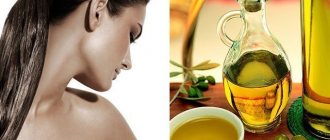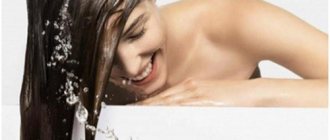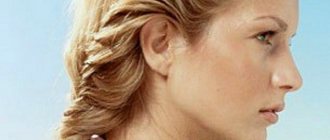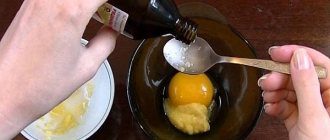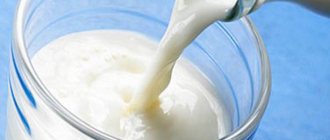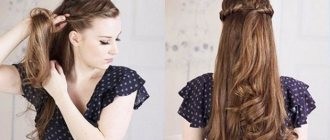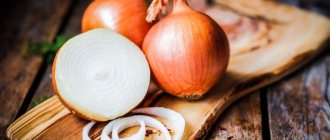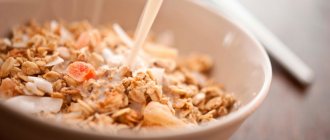Wrong choice of oil
When choosing any hair cosmetics - store-bought or homemade - it is important to consider their type and the problems that you want to solve. This rule also applies to oils! Not every product that is ideal for dry strands will work equally well on oily hair. Dandruff, split ends, dryness and brittleness, increased fat content - each product combats its own problem.
Include in your care only those oils that will have a positive effect specifically on your hair. Olive, linseed, and nutmeg oils are suitable for dry use. In the fight against excessive oily hair, sesame and argan oils will be useful. Coconut and almond oils will mask split ends. Burdock, rice and castor are used to grow and strengthen strands. If you have dandruff, you can include grape and peach oils in your care.
Too much oil on hair
The “more is better” rule when using oil masks for hair definitely does not work. Excess natural product, especially if applied incorrectly, can “clog” the pores on the scalp, which will not be beneficial for the health of your curls. In addition, it is very difficult to wash off oil-based masks from strands. If there is too much of it, even after several rinses, the hair will seem greasy.
How to properly dilute the tint?
If you decide to use store-bought products to tint your hair rather than resort to improvised means, you are probably wondering how to properly dilute hair tint.
There is no universal recipe here. Remember one important rule: before applying the product to your head, carefully read the instructions on its label. As a rule, manufacturers clearly state on the packaging the technology for how to properly use this cosmetic product.
As a rule, manufacturers clearly state on the packaging the technology for how to properly use this cosmetic product.
Usually in such cases it is necessary to combine and mix two components (dye and oxidizing agent), strictly observing the correct proportions. If you bought not a dye for tinting, but a tinted shampoo, you most likely will not have to dilute the product yourself.
Such products are ready to use and can be used immediately (remembering to follow the instructions).
Oil on wet hair
How do you go about applying oil to your hair? As a rule, it is distributed along the entire length of the pre-moistened strands. This is a serious mistake in home care! The application of masks is often accompanied by a parallel massage of the scalp and distribution of oil through the hair with a comb. These procedures can easily injure wet hair - in this state, it reacts sharply to the slightest external influence. In addition, a layer of water on the strands will not allow the beneficial substances from the oil to penetrate into the hair structure - the mask will not “work.”
Experts advise applying oil specifically to dry curls.
How is burdock oil good for hair?
The chemical composition of burdock oil makes it extremely useful for hair care, since it contains the following:
- Vitamin complex - it allows you to maintain a neutral acid-base balance of the scalp;
- Tannins and mineral salts are necessary for nourishing and maintaining the health of the scalp and hair;
- Proteins – help restore microdamage to the hair structure;
- Stearic and palmitic acids are optimal nutrition for hair follicles, preventing premature death of the follicles;
- Natural inulin is necessary for active metabolism and prolongs the life of the hair follicle.
As practice shows, regular use of burdock oil allows you to achieve the following results:
- Dry hair is moisturized, becomes elastic, shiny;
- Damaged and split ends stop splitting, microcracks are filled with protein and the hair looks healthy;
- Healthy hair grows actively, so this home remedy is used to grow hair;
- Oil and massage can effectively remove dry dandruff. The oil penetrates deeply into the layers of dead cells, so that the dead epidermis is softened and, with the help of gentle massaging movements, is simply removed from the surface of the scalp, which cannot be achieved by simply washing the hair;
- Oil masks will allow you not to use conditioner after shampooing - the strands are elastic, well moisturized, and protected from split ends. The oil film actively protects hair from the damaging effects of extreme temperatures - this is especially important in winter, when hair suffers from frost and dry indoor air.
Based on these data, it can be argued that this oil is the optimal product for home care for dry hair. Why are so many girls disappointed in him?
Unheated oil
There is no rush to work with oil masks. Applying a product to your hair that you just took out of the refrigerator where you stored it is a big mistake. There will be little benefit from a home beauty session.
Moderate heating of the oil before the procedure will help ensure that the nutrients from the composition penetrate deeper into the hair structure. This means the curls will absorb all the benefits of the product. Heat the oil a little in a water bath, and then distribute it over the strands.
What if you apply chilled oil to your curls, and then use a hairdryer to “warm up” the composition? Experts do not advise doing this, since there is a risk of making the strands drier and brittle - at high temperatures they will begin to actively lose moisture.
How to use it correctly
There are several options:
The most universal care regimen, which is suitable for owners of hair of any type, is as follows.
burdock oil heated in a water bath is rubbed into the scalp for 15 minutes . To make the procedure easier, the curls can be separated into separate strands using a comb.
After finishing the oil massage of the head, the product can be distributed throughout the entire length of the curls, paying special attention to dry and brittle ends .
A special polyethylene cap is put on the head. It is advisable to wear a warm hat or wrap a towel around your head. The oil wrap exposure time is from 1 hour .
Active scalp massage
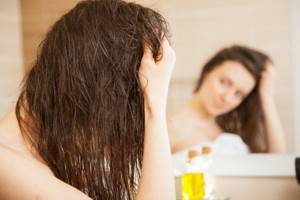
Many of the natural oils are comedogenic. This does not make them any less beneficial for hair. But they should be used with caution. Active massage of the scalp while applying oil to the hair can cause “clogging” of the pores, which will negatively affect the functioning of the sebaceous glands, and, accordingly, the final condition of the curls.
Try not to perform a rough massage, trying to actively rub the natural composition into the scalp. This will definitely not make your strands thicker, smoother or stronger. Distribute the oil over your hair from roots to ends, comb with a soft comb. This way, the right amount will still end up on the scalp.
Capsicum pepper, its “mystery”
In fact, a hair mask made from capsicum tincture can stimulate hair growth. Why does this happen? Capsaicin, which is contained in the product, irritates the skin nerve endings, thereby causing a rush of blood to the hair follicles.
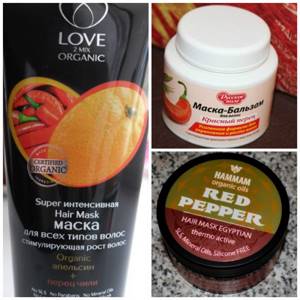
The properties of capsicum are well known to cosmetics manufacturers, so it’s easy to find entire lines labeled “Red pepper.”
This work on the scalp increases the flow of nutrients and stimulates growth. The bulbs that were sleeping wake up and after a few months you can notice a whole squad of “recruits” on the head - small hairs that form a kind of “undercoat”.
To ensure that the hair mask with capsicum does not just irritate the skin, but provides adequate nutrition to the hair follicles, the composition includes a liquid solution of vitamins A and E.
About safety rules
Before you begin “burning” therapy, be sure to read the safety rules.
- When preparing the composition for the first use, use a smaller amount of pepper.
- Start with gentler recipes that also include oils or milk.
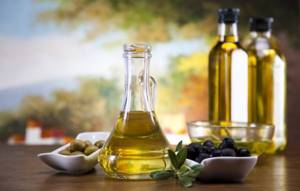
You can reduce the effect of pepper with butter or milk.
- A “fire” on the head when applying the mask indicates that you were generous with the tincture. In this case, it is better not to take risks, otherwise, instead of undercoat and thick curls, you will expect the result in the form of dandruff and burnt skin.
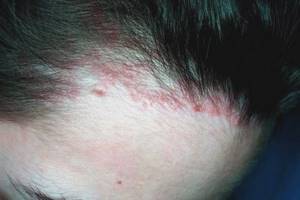
The cost of failure to comply with the proportions and rules for using a mask
- The mask is used in courses; if you do not have visible problems with hair and hair loss, we advise you to postpone preventive procedures until the winter-spring period. It is at this time that the entire body experiences an acute lack of vitamins, which negatively affects the quality and quantity of hair.
Pepper Recipes
| Ingredients | Instructions | |
| 1 | burdock oil – 2 tbsp. spoons; pepper tincture - 2 tbsp. spoons; water – 2 tbsp. spoons | The mixture of components is applied exclusively to the roots of the hair, the head is wrapped in plastic wrap or a shower cap is put on. After 20 minutes, wash off the mask with warm water and shampoo. To warm your head, a regular medical or shower cap is suitable. The procedure is repeated twice a week for a month. After each course, be sure to take a break. |
| 2 | honey – 4 teaspoons; capsicum tincture – 1 teaspoon | Melt the honey in a water bath or in the microwave and mix with the tincture. Use the honey-pepper mixture to massage your scalp. The duration of the procedure is 7–10 minutes. After the massage, wrap your head with film and a terry towel. After 20 minutes, rinse your hair thoroughly with shampoo. The course consists of 4 procedures, performed once a week. |
| 3 | pepper tincture – 1 tbsp. spoon castor oil - 1 tbsp. spoon | The mixture of ingredients is rubbed into the hair roots and left for 2 hours. To increase effectiveness, wrap your head in plastic wrap and carefully wrap it with a towel. After time, rinse the mask with warm (not hot!) water. |
| 4 | onion juice; honey; pepper tincture; Burr oil; (in equal proportions) yolk – 1 pc.; | The mixture is rubbed into the scalp and insulated with a terry towel for 2-2.5 hours. After washing your hair, rinse your hair with a weak lemon solution. |
| 5 | castor oil – 1 tbsp. spoon; onion juice - 2 teaspoons; tincture of calendula and capsicum - 1 tbsp. spoon; honey – 2 teaspoons; cognac – 1 tbsp. spoon; yolk – 1 pc. | Heat the castor oil to a comfortable temperature and combine with the rest of the ingredients. Apply the mask as close to the roots as possible with massage movements. Warm your head and leave it in this state for an hour. After time, rinse with plenty of warm water. |
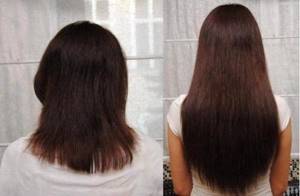
In the photo: the result of the systematic use of a mask “with a spark”, of course, after a while
Preparing the tincture
You can not only purchase pepper infusion at the pharmacy, but also prepare it yourself. This will not require a lot of time, especially if you have a “sparkly” vegetable growing in your garden bed.
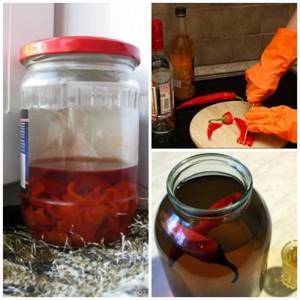
Instructions for preparing homemade pepper tincture
Fill a half-liter glass jar made of dark glass halfway with vodka or alcohol. Peel the peppercorns from the stalks and cut along the pod. Fill the jar until the contents reach the top (see also the article “A castor oil hair mask will make your curls luxurious”).
Close the container tightly with a lid and leave to infuse in a dark, cool place for 2-3 weeks. You can determine the readiness of the tincture by its uniform coloring in red.
A tincture based on vegetable oil will be more gentle, but its stimulating effect is less pronounced.
Oil masks on colored hair
Colored hair requires active nutrition and hydration. That's why many women are starting to use oil masks more often. But this is harmful to the chemical pigment! It is “washed out” from the hair structure much faster under the influence of oils. No wonder this natural product is recommended to all those who want to switch to a natural shade of curls.
If you want to maintain the bright color of your dyed hair, remove oil masks from your home care altogether, or do them no more than once every 2 weeks.
Recipes for combined hair masks based on pepper tincture
The use of pepper in masks is most desirable and advisable, since other components of the cosmetic product somewhat smooth out the aggressive effects of the extract.
Remember! It is important to strictly observe all the proportions of the components of the mask, otherwise it may cause adverse reactions.
Mask with almonds and yogurt
Dilute 15 ml of peppercorns in half a glass of castor oil. Pour in 45 ml of curdled milk and mix well. It is recommended to mix the ingredients in earthenware dishes using a wooden spatula. The curdled milk should be poured in gradually, constantly stirring the composition of the mask.
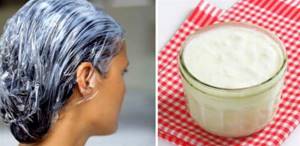
When the mixture is ready, it must be applied immediately. Only the scalp is treated, after which it is wrapped in a cellophane cap and towel. The mask exposure time is 10 minutes.
The remaining mass should be washed off with warm water. Since the mixture contains vegetable oils, you can use shampoo to wash your hair, but it should not have fragrances or dyes.
You may be interested in: Propolis tincture with vodka: preparation at home Medicinal tinctures prepared at home are no less effective than pharmaceutical products. Natural…Read more…
Vitamin almond mask
This mask is good for dandruff, prevents alopecia, strengthens hair and reduces split ends. To prepare the mixture, you need to mix 15 ml of tincture and the same amount of burdock oil in an enamel bowl. Add 3 drops of oil extracts of vitamins A and E into the mixture. Mix all components well, place in a water bath and heat slightly.
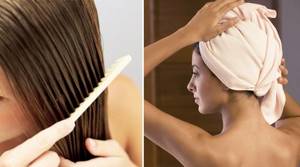
Treat the hair follicles of the head with the resulting mixture.
Rub the mask in with light circular movements. Leave the product on for at least 30 minutes. It is worth considering that for oily hair types, you should not take oil-based vitamins, but injection solutions containing the vitamin itself and water for injection.
Mask with yeast and honey
Dilute 15 ml of peppercorns with 100 ml of milk, which must first be warmed up a little, add 5 ml of honey. Cover the container with a napkin and wait half an hour. After this, mix the mixture again. During the stirring process, slowly add 1 tbsp. l. dry yeast. Mix everything well again and immediately apply the mask to your head. Exposure time – 40 minutes.
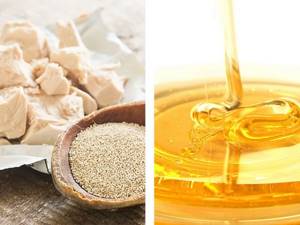
Such cosmetic manipulations need to be carried out 1-3 times a week. The first positive results can be noticed after 2-3 weeks.
Oil in summer hair care
Often treating your hair with natural oils in the summer is considered a big mistake. Even after a thorough rinsing of the strands, part of the composition still remains on them. And the oil will attract the sun's rays, which will provoke active evaporation of moisture from the hair structure. They will become dry and brittle. It turns out that in summer oil masks do not moisturize and nourish the strands, but on the contrary, they only “spoil” them.
In summer, try to use oil masks in your home care as little as possible.
Effects of red pepper on the scalp
The effectiveness of hair masks with pepper is due to the chemical composition of this unusual product. All its components in one way or another affect skin cells, subcutaneous microcirculation, blood circulation, blood vessels, and directly on the follicles themselves, which ensure the vital activity of the entire hair:
- the phenolic compound capsaicin provides an irritant effect: it is this substance that can activate most of the metabolic processes occurring in the cells of the scalp and follicles;
- vitamin A regenerates damaged cells;
- vitamin C increases resistance to external harmful factors;
- vitamin B6 is needed for thickness, activates growth, prevents hair loss;
- potassium moisturizes;
- magnesium strengthens the walls of blood vessels;
- iron provides cells with the necessary amount of oxygen;
- essential oils soothe, soften the irritating effect of capsaicin;
- Fatty oils protect and strengthen.
Any homemade mask with red pepper will have all of the above properties, so it is simply an indispensable activator for hair growth. Improved blood circulation and increased access of oxygen to the follicles awakens them to life and forces frozen cells to recover. The hair is fixed and its active growth begins. The result of such masks is up to 3-4 cm gained per month and a significant reduction in hair loss.
To ensure that the effect of red pepper masks is what you expect, pay close attention to the precautions
Red pepper in hair masks: rules of use
The irritating effect of capsaicin can lead to burns and damage to the scalp, so any pepper-based products at home should be used with extreme caution. Please note that such hair masks with red pepper are contraindicated for any damage to the scalp, very dry hair and vascular or blood diseases
Choose only those recipes that contain a sufficient number of products that soften the aggressive, irritating effect of capsaicin
Please note that such hair masks with red pepper are contraindicated for any damage to the scalp, very dry hair, and vascular or blood diseases. Choose only those recipes that contain a sufficient amount of products that soften the aggressive, irritating effect of capsaicin.
Don't forget to wash your hair before applying the pepper mask - the effect will be better
The best pepper mask recipes
Homemade masks with hot spices are varied, so you can try several to achieve the desired effect.
With red pepper tincture
Mix an alcoholic tincture of pepper (2 tablespoons) with a herbal decoction of eucalyptus, calendula, chamomile, St. John's wort (a tablespoon each).
Balm with added red pepper
Mix alcohol tincture (a tablespoon) with castor oil (the same amount), add hair growth balm (2 tablespoons). Castor oil can be replaced with burdock oil.
Mask: honey and red pepper
Mix pepper tincture (a tablespoon) with fresh linden honey (4 tablespoons), add water (a tablespoon), and heat in a water bath.
Mask with ground pepper
Mix ground red pepper (a tablespoon) with honey (4 tablespoons), which is best preheated in the microwave.
Vitamin mask
Mix pepper tincture (2 tablespoons) with liquid solutions of vitamins A, E (a teaspoon of each).
Mustard mask
Mix ground red pepper and mustard powder (a teaspoon each) with hot water (2 tablespoons), granulated sugar (2 teaspoons), vegetable oil (2 tablespoons) and grind with raw egg yolk. Vegetable oil can be replaced with burdock or castor oil.
All masks with red pepper are very popular, since the result of their impact, unusually rapid effectiveness, is visible after the first use
With proper, careful use, you are guaranteed a cascade of healthy, shining hair.
ARTICLES IN THE TOPIC
Oil “mixes” for making masks
Trying to save on the purchase of high-quality cosmetic hair oils, many women begin to experiment with the composition of masks. The most common mistake is to combine several types of oil at once and apply this “cocktail” to your curls. It is unlikely that these actions will make homemade cosmetics any healthier. On the contrary, there is a risk that the hair will not “accept” the prepared composition. The oil will either be difficult to wash off or make the strands greasy.
Only specialists can combine individual oils into a high-quality cosmetic composition. Special oil hair products from trusted brands have a unique formula and a well-balanced composition carefully verified by specialists. This cannot be repeated at home.
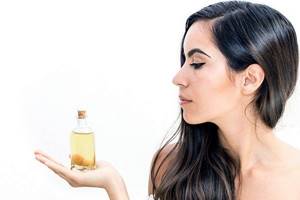
Knowing how women applied oils to their hair back in ancient times
Egypt can preserve their beauty for many years. In the east, natural products used for hair growth, shine, strengthening roots, and feeding them with vitamins were very popular.
Today, hair oil, as a natural product, is superior to many medicated cleansers containing synthetic substances.
Recipes for masks with additional ingredients
A slightly more complex oil wrap recipe involves using a mixture of base and essential oils .
For every 2 tbsp. base, take 2-3 drops of essential substance.
Depending on what effect you want to achieve from skincare procedures, additional ingredients may be used .
To accelerate growth
To prepare a mask to improve hair growth based on burdock oil, 2 tbsp. the product heated to 40 °C with one of the suggested ingredients:
How long should you keep burdock oil on your hair? All the proposed recipes are very effective, but can cause burns on sensitive scalps .
For this reason, the duration of the mask should not exceed 45 minutes , and you should not additionally wear an insulating cap when applying the product.
How to use burdock oil for hair: how much to apply it, how to rub it into your head correctly, make a mask using it against hair loss and for thicker hair - the video will tell you:
Recovery compounds
How to treat hair with burdock oil - the method of application for treatment is simple, the same 2 tbsp. mix the heated product with:
Such recipes are less traumatic for the scalp, so the duration of the masks can be extended to 2 hours using an insulating cap.
The video will tell you how to use burdock oil for hair growth and against hair loss:
How to properly apply oil to hair
Some types of oils are used not only to treat hair, but also to care for eyebrows and eyelashes:
- castor oil (is perfectly absorbed into the hair, reaching deep into the roots, forming a layer that protects it from external damage);
- almond oil (used without additives, prevents fragility);
- burdock oil (mainly used against dandruff and dry hair);
- flaxseed oil (supplies hair tissue with nutrients);
- jojoba oil (normalizes fat content, maintaining hair freshness).
To get the full effect, you need to follow the rules that clearly indicate how to properly apply oil to your hair.
:
- any type of oil should be spread along the length of the hair (not on the head) with a cosmetic brush and combed with a massage brush;
- in order to accelerate blood circulation and blood flow to the roots, it is recommended, without pressing, to massage the scalp with your fingers;
- to get a full result, you need to wear a plastic swimming headdress, but do not pull it tightly so that air can penetrate;
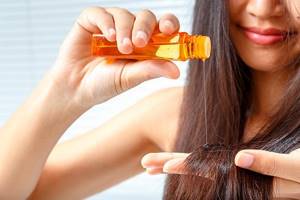
- It is recommended to keep the mask on for 2-3 hours, then thoroughly rinse the oil from your hair. There are oils that can be left on all night (jojoba, flaxseed);
- If your hair is oily, you should not keep the mask on for a long time. As a rule, in such cases, the hair is washed off after an hour.
Jojoba oil is the only product that can be rubbed directly into the scalp. It helps nourish hair follicles with vitamins and penetrate nutrients deep into the roots.
It's all about technique: apply it correctly to the ends
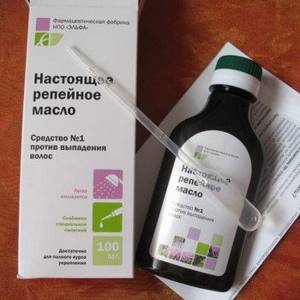
If you leave the oil mask on overnight and find it difficult to sleep with your head covered, simply place a towel on your pillow to avoid getting it dirty.
If enough time has passed and the oil mask is absorbed, it should be washed off well with shampoo in 2 times. I had a period when oils stopped being washed off from my hair, although I had never had such a problem before. Perhaps the hair is simply oversaturated with oils. You just need to monitor their condition. Sometimes it’s worth replacing your care, for example, using cream masks instead of oil masks.
Enveloping oils can tidy up dry hair ends. Of course, split ends cannot be glued together and damaged curls cannot be cured, but oils will help them look good in appearance. Take a drop of oil and rub between your palms. Run these palms over the ends of washed, damp hair. The oils will be absorbed and after drying the hair will not be greasy
Oil heated between your palms can also be applied to the length of washed, damp hair. After drying, the hair will be smooth and shiny. Argan and broccoli oils are well suited for these purposes.
This is done for softness, elasticity, smoothness and shine.
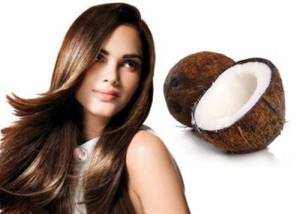
Method No. 1
- Take 2 teaspoons of the drug.
- Rub in, avoiding roots.
- We try to coat every hair.
- We put on a plastic cap.
- We wait 1 hour.
- Wash your hair with mild shampoo.
Method No. 2
- I wash my hair with regular shampoo.
- Lightly dry the ends.
- Separate a small portion of oil.
- Warm it in your palms.
- Apply to dry ends.
Which hair is best to apply oil to?
It should be noted that there are two categories of oils: essential and vegetable. Herbal masks are applied in their pure form, without any additives, for several hours (maximum 3 hours), or overnight. The duration depends on the type of mask. The oil must first be heated by steam until warm.
Essential oils are added to the detergent (shampoo, or other hair washing products) in an amount of only 3-4 drops, otherwise you can burn the scalp, ends and roots of your hair.
The question of whether to apply oil to dry or damp hair still remains relevant.
. Essential oil masks are used in the process of washing hair, as they are additives to the detergent. The mask should be washed off 4-5 minutes after applying it to the strands.
Vegetable oils are divided into fatty (castor, sea buckthorn, burdock) and non-fat, or as they are called dry (cocoa butter, jojoba). The duration of the procedure depends on their quality. Oily types of masks should be left on the hair for no more than an hour (or less - 45 minutes). Cocoa or jojoba butter can be left overnight.
When asked which hair is best to apply oil to, the presenters
cosmetologists have one answer: the hair should be damp (not wet). An exception is castor oil applied to dry split ends of hair. It prevents the process of their damage.
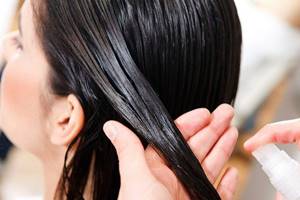
Care products
Leave-in skincare products are effective for eliminating dryness. These include:
- oils;
- sprays;
- vibes;
- creams;
- serum.
They contain substances that help retain moisture in the hair (fatty alcohols, oils, glycerin). Since the product is not washed off, the level of moisture remains constant, the hair becomes elastic, shiny, and alive.
Let's look at the example of several leave-in products to see what effect they give and how they differ.
Oil complexes
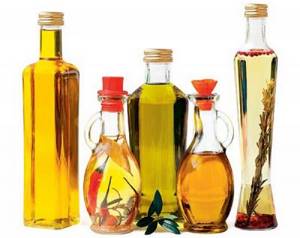
What benefits do oils bring to hair? Let's start with the fact that they are divided into penetrating and covering.
The first penetrate deep into the hair scales, providing protection from damage during the washing process. This is coconut oil, olive oil, avocado oil.
The latter form a protective layer on the hair, preventing moisture from leaving it. These are, for example, jojoba, sunflower, and corn oils. After washing, it is recommended to use covering oils.
Care complexes contain several types of oils, and auxiliary chemicals can be added to them: silicones, proteins, glycerin, etc. Oils should be applied to dry ends after washing in small quantities.
It is important not to overdo it so as not to create a greasy effect.
Oils are good for their natural composition and healing effects, but applying them is not very convenient. In addition, you will need to experiment with different types of oil complexes, as some of them can weigh down or stick your hair together.
Oils suitable for dry hair:
- Natura Siberica, sea buckthorn oil complex;
- Organic Shop, jojoba oil;
- L'Oreal Elseve, extraordinary restorative oil;
- Riche, Hair Oil Amla;
- Ciel Parfum, 9 in 1 oil, protection and shine.
Serums
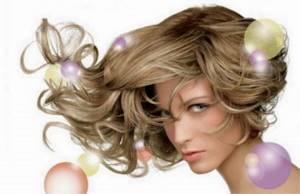
The serum simultaneously moisturizes and treats hair, and also promotes easy styling. It combines the properties of a balm, mousse and mask and will help you form beautiful curls.
The composition includes a restorative conditioner, as well as other components that are aimed at hair restoration: extracts, proteins, oils, biopolymers, panthenol.
The serum components help saturate the scalp with oxygen, accelerate hair growth, and improve its structure. Some serums are applied to the ends of the hair, while others (for example, aimed against hair loss) are applied to the roots.
The serum is convenient due to its multifunctionality: it is both a healing and a styling product.
Examples of anti-dryness serums:
- Tahe Gold Secret, for restoring dry and frizzy hair;
- Kharisma Voltage Daily Nutritive Hair Serum;
- Kapous Dual Renascence 2 phase, moisturizing serum;
- Kapous, moisturizing with argan oil;
- Biocon Hair Strength, for dry and brittle ends.
Sprays
Spray is perhaps the most convenient product to use. It is quick and easy to apply, has an immediate effect, and can be carried with you and sprayed on your hair throughout the day.
The spray most often contains thermal water or herbal decoction. Keratin, oils, silicones, and vitamins are added to them. The composition should be sprayed onto clean hair (dry or damp - depends on the specific type of spray).
The spray can be used during the styling process, but not in conjunction with straightening irons and hair dryers, unless permitted in the instructions. It envelops the hair, creating a film that prevents moisture loss.
Examples of sprays suitable for dry, curly hair:
- Ouidad Botanical Boost Moisture Infusing & Refreshing Spray;
- Wella Elements, hydrating spray conditioner;
- Shiseido Tsubaki Damage Care Hair Water;
- L'oreal Hydra Repair moisturizing conditioner spray;
- Yellow Curly therapy for curly hair care.
Terms of use
When selecting cosmetic oil for your hair, and even more so when mixing them for one procedure, it is important to know not only the functional orientation of each component, but also take into account their general compatibility. And also remember about the possibility of allergies, especially to exotic ingredients. Therefore, before using aromatherapy, masks, wraps or compresses based on vegetable or essential natural oils, you need to make sure of their individual tolerance. It can be easily tested by placing a drop on your wrist and observing the skin reaction.
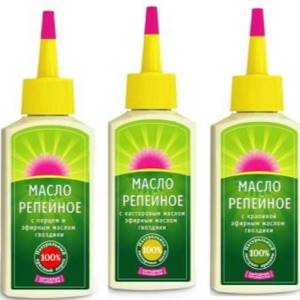
Applying oils at home
- Before use, cosmetic oils should be heated in a water bath to 40-50 °C.
- To prepare your own fruit hair masks, you should first grind the fruits in a blender, then combine them with warm cosmetic oil and mix well again.
- The usual duration of action of combined masks on strands is from 20-30 minutes to 1.5-2 hours, and in their pure form, plant extracts can be left on the hair for 8-12 hours.
- Not all masks can be rubbed into the roots - check the permissibility of this on the label or in the instructions for use.
- To enhance the effect of a mask or wrap, do not put a plastic bag or shower cap on your head (you can overheat your strands) - it is better to use a terry or flannel towel.
- For preventive care, it is enough to apply oil to the hair once a week, and to achieve a therapeutic effect - every 3 days for 2-3 months.
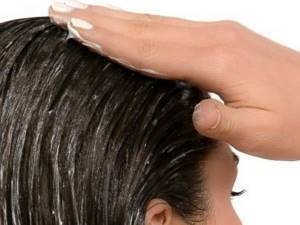
Owners of voluminous hair and short curls often argue about how to properly apply masks based on vegetable or essential oils to their hair. Some people wrap dry strands with them before washing, while others spray them with a spray bottle immediately after a shower, while still wet. There are also those who forcefully rub them into the roots and along the entire length of freshly washed hair, and after 15 minutes they go back to the bathhouse. There is also disagreement about what temperature they should be - cold, warm or hot.
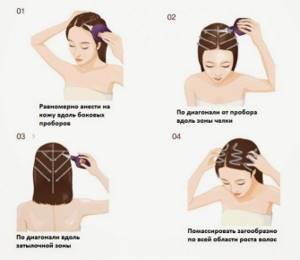
But experts agree: before use, cosmetic oils must be heated to + 40 degrees and certainly in a water bath - this way their aromatic essence will be fully revealed, better absorbed into the hair, roots and skin and will maximize all its beneficial properties.
It is correct to apply cosmetic oil only to clean, well-combed, dry hair (or slightly damp, thoroughly towel-dried). There is no need to specifically wet the strands - oil masks are already sufficiently saturated with moisture and moisturize the curls on their own.
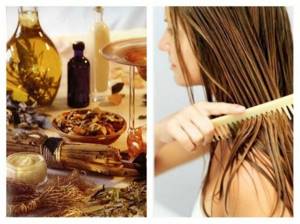
A little secret - so that after using such rather greasy wraps, the strands do not appear dull and greasy, before the procedure they should be washed with the most ordinary shampoo that does not contain collagen. This way, the oil will not fall on the greasy film, but directly on the hair, which will also enhance the penetration of all biologically active substances into its structure.
How to style hair after perm?
Having done long-term salon styling, many women are at a loss as to how to properly style their curls after such a perm. It's simple, just know a few simple secrets.
First of all, remember that proper styling begins with proper washing. Use only specialized shampoos for chemically curled hair. After washing, be sure to apply caring balms, conditioners or masks to your head.
These products will help nourish and restore strands that are weakened and dry after chemical treatment.
Pay special attention to the ends of your hair, which usually suffer the most from the harmful effects of chemicals.
The easiest way to install at home:
- wash your hair;
- blot it with a towel;
- if necessary, apply care or styling products;
- Lightly squeeze the curls with your palms and leave to dry naturally.
Besides this simple method, there are several more complex styling methods. You can style your curls with a hairdryer and diffuser, roll them with curlers, create large curls using a round brush, or try out other styling options. Below we will look in more detail at the most popular of these technologies for creating a beautiful hairstyle.
Using a hair dryer
Ideally, after getting a perm, it is better to avoid using a hair dryer altogether. Frequent heat drying can disrupt the curl shape and make it less durable.
In addition, after drying with a hairdryer, curled hair can become very fluffy, and it will not be easy to collect it into a neat and beautiful hairstyle.
If you do use a hairdryer, do so as rarely as possible, and very wisely and carefully. First of all, you need to choose a suitable attachment for this type of hair.
A nozzle with a diffuser would be ideal.
When using it, the strands will not fluff very much, which means that the hairstyle will look much better.
If you do get a slight frizz effect when drying with a diffuser, you can easily eliminate it by smoothing your hair with a comb or adding a little styling to it.
You can watch the video on how to style using a diffuser:
Rolling on curlers
A perm can serve as an excellent basis for creating curls using curlers or other improvised devices.
By curling your hair with curlers, you can enhance the perm effect or get larger curls.
It all depends on what type and size of curlers you choose.
You can use curlers or bobbins of approximately the same size that the master used when creating your chemical product. Or you can choose larger diameter curlers to get the effect of lush curls.
Curling chemically-curled hair with curlers is no more difficult than straight strands.
- Just divide your cleanly washed hair into strands, dry them a little, apply styling and curl them with curlers.
- After this, you can additionally treat the curled hair with a special spray to fix the curls.
- Then leave the curlers on your head until your hair is completely dry.
Creating Beach Style Curls
A hairstyle in the style of wet hair looks very good on curly strands. This style is quite simple to do, and it can last all day.
- To get that trendy wet hair effect, start by washing your hair.
- Gently divide wet hair into sections using a wide-tooth comb.
- Apply a small amount of hair gel (or another product specifically designed for wet hair styling) to each section.
- Use your hands to squeeze your curls a little to give them the desired shape and to better distribute the gel.
- After that, you just have to wait for your hair to dry naturally.
With this styling method, it is important not to overdo it with gel or other styling products. Excessive amount of gel on your hair can ruin your entire hairstyle.
Instead of the desired effect of wet strands, you risk getting unnaturally glued strands, or hair that will not look wet, but dirty and greasy.
If you are afraid of this effect, use the gel to a minimum, or replace it with a special moisturizing spray to give your hair a wet effect. It is better to use this spray on dry hair.
Beneficial features
Cosmetic oils for hair care are rather fatty substances created on the basis of extracts that are obtained by cold pressing of beneficial plants and are practically insoluble in water. During industrial production, their natural organic base is often replaced with a mineral or synthetic one and mixed with fragrances, preservatives, dyes and other delights of chemical cosmetology. Which, to put it mildly, does not add any usefulness to them, and therefore is increasingly reviving the interest of beauties in natural hair care products.
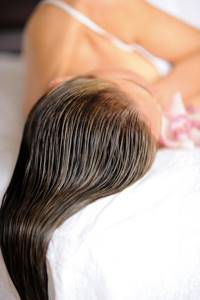
Vegetable oils are completely safe because their composition is similar to human sebum. They are great for almost everyone (even with irritated and very sensitive scalp) and extremely rarely cause allergies. Natural plant extracts are perfectly absorbed, delivering maximum beneficial substances to the strands, and are used either in pure form or as a biologically active vitamin supplement to store-bought masks. They are equally good for all hair types, beneficial for the delicate skin around the eyes and for dry and aging skin of the face and scalp.
With the help of vegetable oils, you can strengthen not only curls, but also nails, as well as eliminate cosmetic defects of the skin of the face, hands and body, and even treat some dermatological diseases.
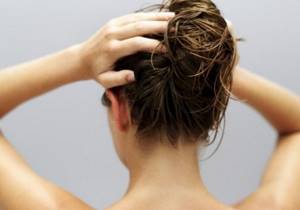
Properties of vegetable oils
- Anti-inflammatory.
- Normalization of secretions.
- Activation of collagen synthesis in the scalp.
- Gentle cleansing and aromatic toning.
- Softening and moisturizing curls and roots.
- Thickening thinning and strengthening weakened strands.
- Saturation with useful microelements along the entire length.
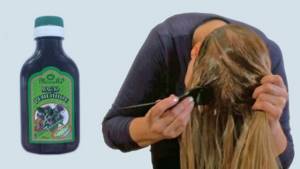
Essential oils differ from vegetable oils in that they are more concentrated and less fatty. They cannot be applied in their pure form to the roots and hair - you need to mix a few drops with vegetable or synthetic cosmetic oils or with ready-made balms, shampoos or masks. Otherwise, incredibly rich essential compounds will harm the fragile hair structure and delicate skin.
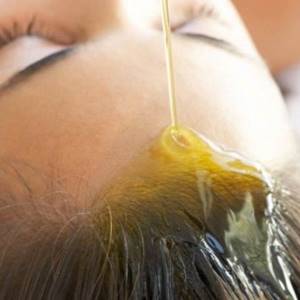
Essential oils - for hair strength
- Activation of skin regeneration.
- Follicle restoration.
- Strengthening hair roots and structure.
- Active saturation with vitamins A, C, P, B and D.
- Nourishes and smoothes strands along the entire length.
- Stimulation of curl growth and aromatic toning.
- Elimination of dandruff, itching, oiliness and dryness.
- Stabilization of the functions of sebaceous secretions.
- The ability to thicken hair, lighten its tone or remove color.

The most popular means
- burdock, flaxseed, almond, grape and cocoa butter - general strengthening and nutrition of the follicles and scalp, activating hair growth and giving a healthy shine;
- castor, coconut, sea buckthorn and ylang-ylang oil - treatment of damaged and weakened strands, restoration of split ends, getting rid of dandruff;
- wheat germ oil - effective elimination of excessive hair loss;
- argan and peach oils - saturating the hair with useful substances, promoting natural radiance, increasing thickness and volume;
- amla oil - giving strands lightness, softness and silkiness;
- Jojoba and macadamia oils - abundant hydration, high-quality restoration and smoothing of dried out strands along the entire length
You will learn from the video how to properly apply oil to your hair and which oil is best to buy.
The best hair oils for restoration, effective mask recipes
In addition to ready-made cosmetic products that solve the problem of restoring damaged strands, there are a large number of natural products - base and essential oils, which can be used independently, as well as added to homemade masks.
Among vegetable oils for restoring damaged hair, the most effective ones can be identified.
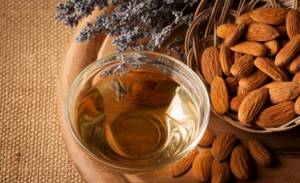
Almond
It helps strengthen curls, improves their growth, increases elasticity, and provides protection from weather conditions. Almond oil eliminates dandruff by regulating the activity of the sebaceous glands, and also helps restore hair damaged as a result of dyeing or the use of thermal devices for styling strands.
How to use? To prevent the oil product from making your curls too greasy, it is enough to use only 1 to 3 spoons, depending on the length and thickness of your hair.
Moisturizing mask
Oils: almond (2 tablespoons) and aloe (12 teaspoons) + honey (1 tablespoon) + yolk (2 pieces).
Apply to the entire length of the strands and leave for 40 minutes. Promotes hydration, nutrition, smoothness of hair, making it more manageable.
Coconut
Gives good hydration and nutrition to curls, protects from the sun, exposure to sea and chlorinated water, enhances the growth of strands and makes them more manageable.
How to use? Coconut squeeze can be used as a mask or added to shampoo. It may not be useful for all types of strands: it can make oily scalps more greasy, and it can make naturally thin curls very heavy. It is enough to try applying the oil product just once to understand whether it is suitable or not.
Revitalizing shine mask
Coconut oil (2 tablespoons) + apple cider vinegar and honey (1 tablespoon each).
Heat the oil mixture, mix it with honey and, lastly, with vinegar. Mixture exposure time: for normal type strands – 20 minutes, dry and porous – an hour.
Burdock
It is rightfully considered the undisputed leader for preparing medicinal mixtures and hair masks at home; it is found in most folk recipes. Burdock oil, in addition to restoration, fights dandruff and hair loss. Nourishes curls, enveloping each hair with a thin invisible film, providing protection from adverse external factors, hot styling tools, moisturizes, helps overcome excessive dryness and promotes increased growth of strands.
How to use? Helps protect hair from chlorinated pool water, restore hair after dyeing and bleaching, promote the growth of eyelashes and eyebrows. It is permissible to use both solo and as part of masks. Burdock oil is easy to prepare at home yourself.
Mask with kefir for hair weakened after blow-drying or coloring
Oil product (1 tablespoon) + kefir (50 ml) + liquid honey (1/2 tablespoon) + yolk. Exposure time: 40 minutes - hour.
Castor
Castor oil gives shine to curls, treats split ends, stimulates growth, moisturizes, strengthens and makes strands thicker.
How to use? More suitable for moisturizing curls prone to dryness or hair with dry ends and oily roots. But in this case, the oil product should be used only for the ends. Castor oil is also effective for the growth of eyebrows and eyelashes.
When choosing an oil preparation, it is better to choose a product of a lighter shade; it is better purified. It cannot be applied to the ends of strands without rinsing, it is very thick. Frequent use of castor oil may cause some types of hair to darken.
Revitalizing mask with egg
Castor oil (1 tablespoon) + yolk (2 pcs).
Heat the oil mixture a little in a water bath, pour in the egg. Distribute over the scalp and the entire length of the strands, leave for 40 minutes. Rinse with plenty of water using shampoo. You can rinse your hair with a vinegar solution or nettle decoction.
Olive
Olive squeeze, in addition to moisturizing dry curls, promotes their rapid growth, restores strands after chemical exposure, softens them and gives the hair a healthy shine.
How to use? It is better to use a first cold-pressed, unrefined product with a yellow-green tint. It costs more, but the effect of its use will be more noticeable. In addition to preparing hair masks, olive oil is useful for eating - 1 tablespoon per day is enough. An excellent preventive remedy for various problems with the scalp and hair is a massage of the root zone with olive oil.
Mask for restoring depleted, dull strands
Oils: almond and olive (1 tablespoon each) + vitamins A and E (½ teaspoon each).
Exposure time – 40 minutes. The mixture nourishes, protects against breakage, adds shine and relieves curls from excessive dryness.
Sunflower
It moisturizes, normalizes sebum secretion, restores hair damaged by chemical dyes, and adds shine and smoothness.
How to use? You need to use an unrefined product obtained by cold pressing. Sunflower seed squeeze is especially effective when mixed with mustard, yolks and honey.
Nourishing mask recipe
Basic oil remedy (5 tablespoons) + lemon juice (1/2 teaspoon) + egg.
Apply the mixture first to the root area, then use a comb to distribute along the entire length of the strands.
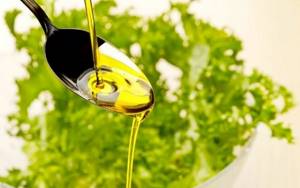
Mustard
An oil product obtained from mustard seeds has nourishing, moisturizing and healing properties. It restores weakened, dull curls, increases blood circulation in the scalp, stimulating the growth of strands. Adds volume, smoothes hair scales, eliminating hair frizz.
How to use? Not recommended for pregnant women, as well as for people with particularly sensitive scalp, if there are abrasions or fresh wounds on it. But it is perfect for restoring damaged, porous and dry hair.
Mask recipe
Oils: burdock (or almond, jojoba, olive, etc. to choose from - 2 tablespoons) and mustard (1 tablespoon) + lemon juice (2-3 drops).
Heat the burdock remedy in a water bath, add mustard and squeeze out the juice from the citrus. Apply the mixture all the way to the ends, leave for 15-20 minutes. Wash off with shampoo.
Linen
Extract of flaxseeds treats hair loss, fights dry ends, moisturizes and nourishes curls along the entire length, protects and gets rid of dandruff.
How to use? Suitable for any type of strands. For maximum benefit, it is better to take additional flaxseed oil with food (add a little to salads and cereals). To accelerate growth, rub the pure oil product into the scalp.
It is permissible to keep masks with it on for at least 2 hours. The oil product has a characteristic aroma, which can be overpowered by adding esters of lavender, ylang-ylang, myrrh, orange or chamomile to the mixture. You can add a couple of drops to a single dose of hair balm and use it as usual.
Revitalizing mixture for colored curls for shine
Oils: grape and flaxseed (2 tablespoons each) + dimexide (1/2 teaspoon).
Mix the oil components and heat a little in a water bath, add dimexide. Apply to roots and entire length of strands. Leave the mask to act for half an hour, rinse with plenty of clean water and shampoo.
Avocado oil
The fatty product helps get rid of seborrhea, moisturizes excessively dry and lifeless curls, protects against external influences, accelerates growth and restores damaged hair.
How to use? The product is suitable for all types of strands. It is better to use an unrefined product, course: 2-3 months with a frequency of using masks 1-2 rubles/week.
Blend for restoring dry and damaged hair
Oils: avocado and olives (10-15 ml each).
Mix the warm oil components, apply to the root zone of the head, distribute along the entire length, especially oil the ends. Insulate and leave for an hour to an hour and a half. Wash off with shampoo.
By the way
You can add your choice of liquid vitamins A, C, E or a spoonful of cognac (pepper tincture) to the mask to awaken dormant bulbs and stimulate strand growth.
Peach
It helps restore weakened, damaged strands, moisturize the scalp and curls along the entire length, cares for the ends of the hair, and gives it a healthy shine.
Nourishing and restorative mixture for porous, damaged curls
Peach pit squeeze (1 tbsp.) + mayonnaise (2 tbsp.).
Mix and apply for 40 minutes. It is better not to use the mask for healthy hair, because the curls will not be able to absorb so much fat and there is a risk of getting greasy hair. This texture of the mixture is ideal for dry, damaged and porous curls.
It is useful to use peach oil in its pure form if the curls are damaged by thermal styling devices. Course: at least 2 months.
Wheat germ oil
It makes curls more manageable, smooth, moisturizes and nourishes excessively dry and brittle strands, normalizes sebum secretion and stimulates growth.
How to use? More effective when mixed with other base oils (peach, almond, grape and apricot kernels).
Nourishing mask with avocado oil for damaged and dry hair
Oils: wheat germ and avocado (10-15 ml each) + ylang-ylang ether (4 drops).
Rub the mixture into the scalp, spread along the entire length, paying special attention to the ends of the strands. Insulate, wash your hair as usual after an hour.
Argan
It is considered one of the most expensive oil products. Its properties are amazing: it heals, nourishes and restores curls damaged for various reasons, gives them a healthy shine, protects them from sea water, ultraviolet radiation, wind and temperature changes. In addition, it helps with hair loss and treats brittle and dry ends.
How to use? The oil product is quite thick and quite difficult to use in its pure form. Therefore, it is better to mix it in masks with other natural oils, for example, burdock. The drug is quite allergenic, so before using it for the first time it is advisable to do a sensitivity test. Reveals its beneficial properties on clean, only washed curls.
Nourishment, restoration and hydration of hair
Oils: castor, argan, olive (20 ml each) + yolk + liquid honey (20 ml).
Shake the yolk, add slightly warmed honey and a little later the remaining ingredients, which are also best heated in a water bath. All actions must be carried out while constantly stirring the mixture. Rub into the root area, distribute the rest along the entire length to the ends. Leave for an hour and rinse with lukewarm water and natural shampoo.
Vinogradnoye
It accelerates blood circulation in the scalp, thereby stimulating the growth of new hairs, saves from fragility, and prevents the appearance of split ends of strands.
How to use? It is more effective to apply masks with grape seed extract to clean, slightly damp hair; it is better to wash it off with sulfate-free shampoos. Use oil mixtures no more than once every 7 days.
Moisturizing mask
Oils: jojoba and grape seed (1 tablespoon each) + ylang-ylang ether (5-8 drops).
Mix and apply to the entire hair, stepping back a little from the roots. Insulate or heat with a hairdryer, hold for 60 minutes, then rinse the curls with shampoo.
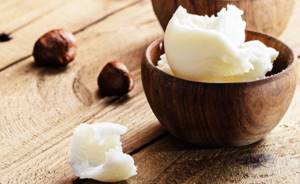
Shea Butter
Shea butter or shea butter treats brittle, damaged, porous strands, restores their structure, eliminates split ends, and adds manageability, elasticity and smoothness to the hair.
How to use? It should be borne in mind that the oil product takes a long time to be absorbed, but gives an excellent nourishing and moisturizing effect for the scalp. It is advisable to choose an unrefined product, handmade in African countries - where the shea tree grows.
Before use, the shea butter must be heated in a water bath to give it a liquid form, more suitable for application to curls. The oil product works great when combined with solid coconut and cocoa oils. Good to use throughout the night (no more than 1 teaspoon for medium-length curls).
Curl-restoring composition
Shea butter (1.5 tablespoons) + sandalwood ether (4 drops) + liquid vitamins A and E (1 teaspoon each).
Melt the butter in a water bath, add the remaining components of the mixture. Apply to the root zone and the entire hair shaft, insulate, leave for 2 hours. Rinse off as usual.

